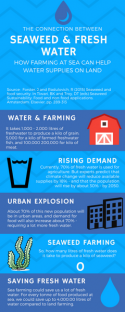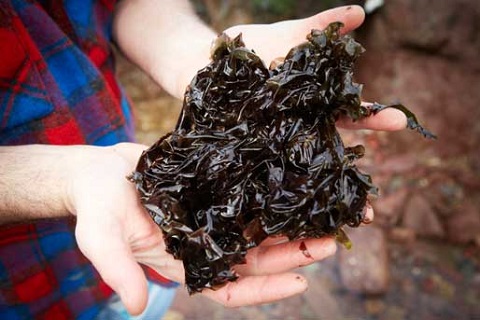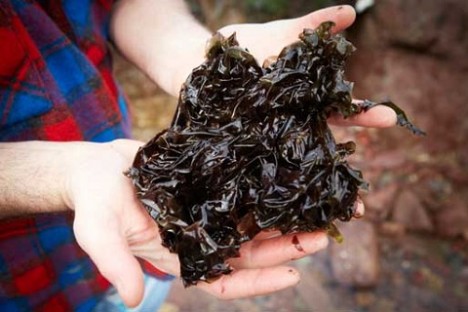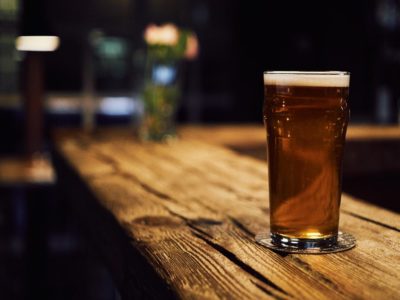Seaweed for a sustainable future
Seaweed isn’t just an interesting ingredient that can add a new dimension to your dishes, it might also play in important part in sustainable food farming in the face of climate change and a rapidly rising population.
Click to enlarge
If you’d like to learn about Welsh seaweed farming, visit the Algae Wales website.
They have information on past and ongoing projects, as well as informational videos and news of upcoming events.
This video by EU Science & Innovation discusses seaweed farming for food, but also as a source of material for biochemicals and biofuels.
The traditional Welsh favourite is on the rise in the Cardiff food scene as both cooks and diners learn to appreciate its versatility
Looking like nothing so much as a blob of black sludge, laver seaweed isn’t the prettiest of foods. However, it was once a South Wales staple, until modern food technologies and changing tastes pushed it out of the spotlight.
Recently, however, a new generation of Welsh foodies have rediscovered the sea vegetable and are inventing up-to-date, exciting dishes that showcase its distinctive flavour.
Laver is porphyra umbilicalis, a red seaweed that is only found along the coasts of the Irish Sea. It’s often said to be the same as its cousin, the better-known Japanese nori, but they’re different varieties of the same species.
Jonathan Williams, founder and owner of the Pembrokeshire Beach Food Company, explains the difference by comparing them to different types of red grape: “Their tastes are similar, but they have different qualities.”
It’s not clear when the people of Wales started eating laver. Some date it to the Vikings, but there are archaeologists who believe that the Welsh have been eating local sea vegetables along with cockles and mussels since prehistoric times.
The seaweed became identified with Welsh, and in particular South Walian, cuisine, and was an important part of local food identity until processed foods became widely available in the mid-20th century. By the 1970s, laver was at its lowest point: rarely eaten and with only one company processing and selling it.
A foodie renaissance
In the following decades, however, a combination of the growing popularity of Asian cuisine, especially sushi, rising awareness of the need to find more sustainable food sources, and greater confidence in Welsh food led to a resurgence in the use of laver.
Today, there are a number of B&Bs and cafés offering laverbread, which is cooked seaweed mixed with oats and fried, as part of a Welsh Breakfast, including Cardiff’s Garlands and the Bull Terrier Café. But there are also innovators incorporating laver into their dishes in new and exciting ways.
Jonathan’s Pembrokeshire Beach Food Company harvest and process laver and other native seaweeds. They then sell them at festivals, through their deli range online and in shops, and at their seasonal Café Môr. Their website has recipes for each of their products, and the ideas for laver range from pairing it with scallop and bacon in a butty to mixing it in porridge with berries.
Explaining what inspired the company to develop such off-the-wall ideas for the seaweed, Jonathan says, “It’s not just a fantastic ingredient; it’s not just packed full of healthy nutrients; it adds flavour to your food and we want to get you to the point where you use it like you use any other herb on the rack.”
Cardiff Welsh food champion Sian Roberts has produced versions of traditional Welsh dishes such as laverbread, but says Welsh cooks need to “bring them into the 21st century” in the same way the French and Italians constantly update their cuisines.
Not even its biggest fans would call processed laver pretty
“On its own, it’s not the most attractive dish,” Sian concedes. “It’s quite a Marmite-type product, but it’s also a versatile ingredient you can use in lots of different dishes.”
She has incorporated laver into such dishes as a dip for crisps and crudités and a lasagna with spinach. When asked what inspired her to find such novel uses for the seaweed, she laughs. “I think I was hiding it from my sons,” she says. Sian also makes a laver soup as a vegetarian option at cooking demonstrations when she makes traditional Welsh cawl, and the meat-eaters frequently prefer the veggie version.
Dusty Knuckle Pizza is a new Cardiff restaurant that has won awards for their creative topping combinations. One of their most famous creations has been the Blas y Môr pizza which is topped with cockles, bacon and laver. “It’s accidentally become our signature pizza,” says co-owner and founder Phill Lewis. And indeed, Blas y Môr has gone viral, earning mentions in the Times, Guardian and Telegraph, as well as being recently voted one of the Top 8 pizzas on Snapchat.
But Blas y Môr isn’t the only dish at Dusty Knuckle Pizza featuring the seaweed. They sometimes stir it through sauerkraut and their antipasti board features rye and laver crackers from Cardiff’s Inner City Pickle, which owner Eira devised especially for them.
Suggestions for curious cooks
As anyone who’s bought seaweed for home cooking knows, it can be expensive unless you know the right place to buy. A 120g tin of processed laver can cost upwards of £1.75, but E Ashton Fishmongers sells it by weight at 85p per 100g.
Sian’s tasty soup is a perfect winter warmer
But what’s the best way for the uninitiated to give this sea vegetable a try? Both Sian and Jonathan agree that adding a small amount to familiar dishes will give you an idea of what laver can do without being overwhelming.
Sian likens the seaweed to avocados, which are not very special on their own, but come to life when dressed with a vinaigrette. “Laver is the same,” she says. “You add some lemon or orange juice and parsley and cook with it, and suddenly it becomes an interesting ingredient.”
Jonathan suggests adding a tablespoon or two to a curry, Bolognese sauce or chili con carne. “It’s got such a great depth of flavour,” he says. And even if it isn’t immediately apparent, “It’s still there in the background.”
Laver is well on the way to coming full circle on its journey through Welsh food history. Having plunged in popularity from regional favourite to near extinction, it’s enjoying a renaissance as Wales’ latest food innovators dream up cutting-edge, delicious ways to showcase laver’s unique character.
Related stories:
For more information on food innovation in the Capital, read about top takeaway Katiwok and the indie food scene. If you’re interested in ethical food choices, there are articles on Cardiff’s sustainable street food and sustainable fishing initiatives.
Seaweed for a sustainable future
Seaweed isn’t just an interesting ingredient that can add a new dimension to your dishes, it might also play in important part in sustainable food farming in the face of climate change and a rapidly rising population.
Click to enlarge
If you’d like to learn about Welsh seaweed farming, visit the Algae Wales website.
They have information on past and ongoing projects, as well as informational videos and news of upcoming events.
This video by EU Science & Innovation discusses seaweed farming for food, but also as a source of material for biochemicals and biofuels.







